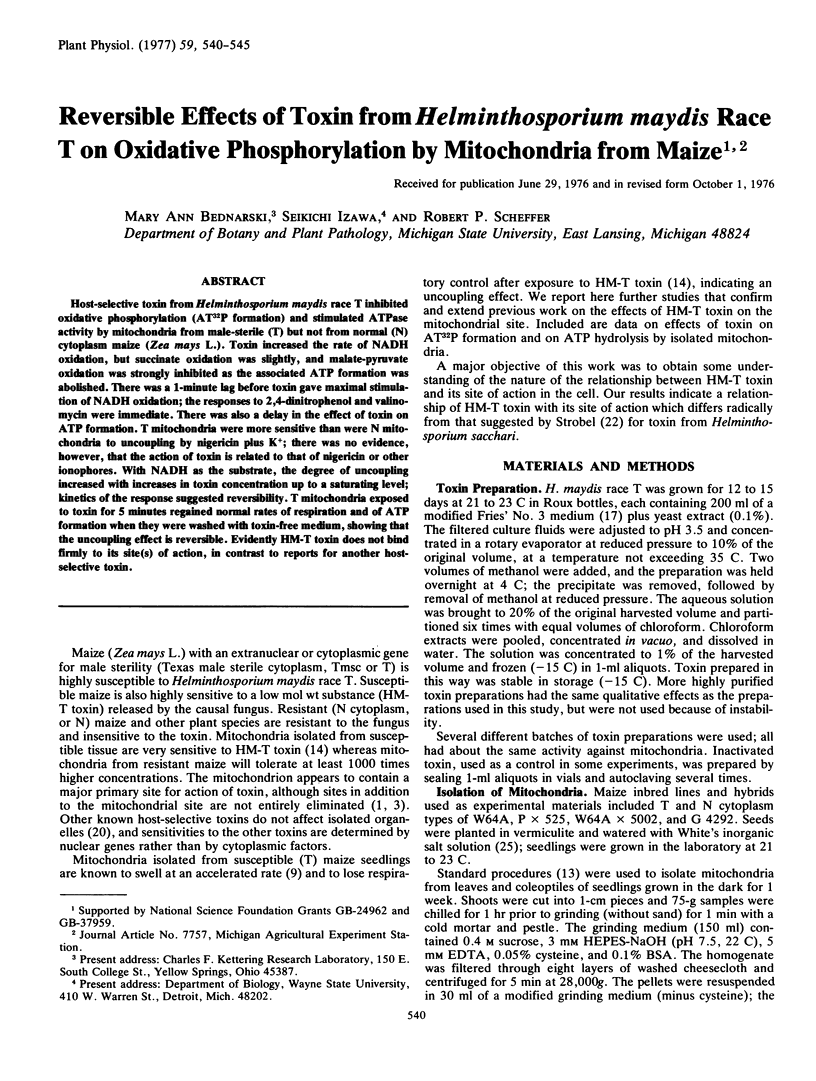Abstract
Host-selective toxin from Helminthosporium maydis race T inhibited oxidative phosphorylation (AT32P formation) and stimulated ATPase activity by mitochondria from male-sterile (T) but not from normal (N) cytoplasm maize (Zea mays L.). Toxin increased the rate of NADH oxidation, but succinate oxidation was slightly, and malate-pyruvate oxidation was strongly inhibited as the associated ATP formation was abolished. There was a 1-minute lag before toxin gave maximal stimulation of NADH oxidation; the responses to 2,4-dinitrophenol and valinomycin were immediate. There was also a delay in the effect of toxin on ATP formation. T mitochondria were more sensitive than were N mitochondria to uncoupling by nigericin plus K+; there was no evidence, however, that the action of toxin is related to that of nigericin or other ionophores. With NADH as the substrate, the degree of uncoupling increased with increases in toxin concentration up to a saturating level; kinetics of the response suggested reversibility. T mitochondria exposed to toxin for 5 minutes regained normal rates of respiration and of ATP formation when they were washed with toxin-free medium, showing that the uncoupling effect is reversible. Evidently HM-T toxin does not bind firmly to its site(s) of action, in contrast to reports for another hostselective toxin.
Full text
PDF





Selected References
These references are in PubMed. This may not be the complete list of references from this article.
- Arntzen C. J., Haugh M. F., Bobick S. Induction of Stomatal Closure by Helminthosporium maydis Pathotoxin. Plant Physiol. 1973 Dec;52(6):569–574. doi: 10.1104/pp.52.6.569. [DOI] [PMC free article] [PubMed] [Google Scholar]
- Bhullar B. S., Daly J. M., Rehfeld D. W. Inhibition of Dark CO(2) Fixation and Photosynthesis in Leaf Discs of Corn Susceptible to the Host-specific Toxin Produced by Helminthosporium maydis, Race T. Plant Physiol. 1975 Jul;56(1):1–7. doi: 10.1104/pp.56.1.1. [DOI] [PMC free article] [PubMed] [Google Scholar]
- Estrada-O S., Graven S. N., Lardy H. A. Potassium Ion-dependent hydrolysis of adenosine triphosphate induced by nigericin in mitochondria. J Biol Chem. 1967 Jun 25;242(12):2925–2932. [PubMed] [Google Scholar]
- Filner P. Regulation of nitrate reductase in cultured tobacco cells. Biochim Biophys Acta. 1966 May 5;118(2):299–310. doi: 10.1016/s0926-6593(66)80038-3. [DOI] [PubMed] [Google Scholar]
- Koeppe D. E., Miller R. J. Some effects of decenylsuccinic Acid on isolated corn mitochondria. Plant Physiol. 1971 Dec;48(6):659–662. doi: 10.1104/pp.48.6.659. [DOI] [PMC free article] [PubMed] [Google Scholar]
- LOWRY O. H., ROSEBROUGH N. J., FARR A. L., RANDALL R. J. Protein measurement with the Folin phenol reagent. J Biol Chem. 1951 Nov;193(1):265–275. [PubMed] [Google Scholar]
- Miller R. J., Dumford S. W., Koeppe D. E., Hanson J. B. Divalent cation stimulation of substrate oxidation by corn mitochondria. Plant Physiol. 1970 Jun;45(6):649–653. doi: 10.1104/pp.45.6.649. [DOI] [PMC free article] [PubMed] [Google Scholar]
- Miller R. J., Dumford W. S., Koeppe D. E. Effects of gramicidin on corn mitochondria. Plant Physiol. 1970 Sep;46(3):471–474. doi: 10.1104/pp.46.3.471. [DOI] [PMC free article] [PubMed] [Google Scholar]
- Miller R. J., Koeppe D. E. Southern corn leaf blight: susceptible and resistant mitochondria. Science. 1971 Jul 2;173(3991):67–69. doi: 10.1126/science.173.3991.67. [DOI] [PubMed] [Google Scholar]
- NIELSEN S. O., LEHNINGER A. L. Phosphorylation coupled to the oxidation of ferrocytochrome c. J Biol Chem. 1955 Aug;215(2):555–570. [PubMed] [Google Scholar]
- Pring D. R. Maize Mitochondria: Cytochromes of Fertile and Cytoplasmic Male-sterile Lines. Plant Physiol. 1975 Feb;55(2):203–206. doi: 10.1104/pp.55.2.203. [DOI] [PMC free article] [PubMed] [Google Scholar]
- Saha S., Good N. E. Products of the photophosphorylation reaction. J Biol Chem. 1970 Oct 10;245(19):5017–5021. [PubMed] [Google Scholar]
- Strobel G. A. The helminthosporoside-binding protein of sugarcane. Its properties and relationship to susceptibility to the eye spot disease. J Biol Chem. 1973 Feb 25;248(4):1321–1328. [PubMed] [Google Scholar]


